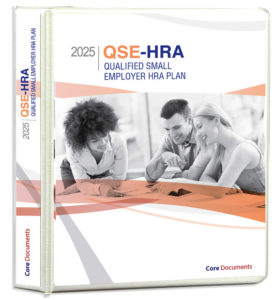Home / Blog / What is the QSE-HRA no group health plan rule?
What is the QSE-HRA no group health plan rule?

QSE-HRA basics
The Qualified Small Employer Health Reimbursement Arrangement (QSE-HRA) is an employee benefit plan designed especially for companies with fewer than 50 full-time employees. The plan allows employers to provide funds employees can use to be reimbursed for health insurance premiums and qualified out-of-pocket medical expenses without requiring the employer to first provide a group health plan. The QSE-HRA no group health plan feature makes it an affordable way small employers can help employees offset personal health care expenses.
No GHP means none at all
The QSE-HRA no group health plan feature is so central to its plan design that it is a fundamental eligibility requirement. If the employer offers any kind of group health plan at all for active employees, that employer may not also offer the QSE-HRA.
HRA News:
The new Individual Coverage HRA is available for employee groups of any size, reimburses employees for health insurance premiums, and has a grandfathering option for employees currently covered by a traditional employer-sponsored group health plan. Learn more.
For 2024, the maximum allowed QSE-HRA annual benefit is $6,150 per employee electing individual coverage, and $12,450 per employee electing family coverage.
Funding level
Employers choose how much to fund the QSE-HRA (it is entirely employer funded). This can be any amount up to the annual limits set by the IRS each year. For 2024, the maximum allowed annual benefit is $6,150 per employee electing individual coverage, and $12,450 per employee electing family coverage.
Proof of MEC for employee reimbursement
Employees participating in the plan must provide proof of Minimal Essential Coverage (MEC) for the employee and any covered dependents before the QSE-HRA reimburses them for any eligible medical expense. Employees purchasing coverage on their own will submit proof of MEC when seeking reimbursement for their health insurance premium; otherwise, proof of MEC will come from the spouse or parent group health plan covering the employee as a dependent.
It is important to understand clearly that while the employer may not provide any kind of group health insurance for employees — none at all — the employee is required by law to have his or her own coverage (and coverage for any eligible dependent covered under the QSE-HRA) before receiving any reimbursement at all.
For example, an employee cannot go without buying their own MEC and then ask for QSE-HRA reimbursement of non-premium out-of-pocket medical expenses.
W-2 reporting and tax treatment
Funds reimbursed through a QSE-HRA are tax-deductible for both the employer and employee. W-2 reporting is required but will not affect the employee’s taxes unless the employee (1) failed to report the amount of the QSE-HRA on the ACA Health Insurance Marketplace and received a premium tax credit to buy insurance or (2) received reimbursement during a period of time when their MEC had lapsed.
The bottom line
Does the QSE-HRA no group health plan rule make it a perfect fit for thousands of small employers? Yes, because it makes health care benefits for employees within the grasp of even the smallest company with only one or a handful of employees.

QSEHRA Plan Document Package

Our friendly and knowledgeable staff is available to
answer any questions you may have via e-mail or phone call,
Monday through Friday, 9 am to 5 pm ET:
1-888-755-3373
No annual fee — Core Documents does not require an annual renewal fee to maintain your plan document package. A plan document only needs to be updated when there are changes in the plan or in the law that make it necessary. We will notify you when there are sufficient changes in the Code to require amending and restating your Plan and ask that you keep us informed when there is a change to your plan. You can amend and update your plan document anytime, at a discounted fee and only when necessary, which is the most cost-effective way to maintain it.
*Fast Service — Most orders placed by 3 PM are returned via email the same day, Monday through Friday. Weekend orders are sent out Monday morning. Plan document packages are processed in the order received. During our busiest months (December, January, and February), the rush order fee (see order form) marks your document to be processed immediately.
Refund Policy: Goods and services provided by Core Documents, Inc. are non-refundable upon receipt. Orders cancelled prior to shipping are subject to a fee to cover the cost of goods and services provided during the review, draft, and preparation of your order.
The Trusted Source of Affordable Benefit Plan Documents for over 27 Years.
Core Documents is the country’s leading provider of cost-effective, tax-saving benefit plan documents for Section 125 Cafeteria plans and Health Reimbursement Arrangements. The Trusted Source since 1997, thousands of satisfied agents and employer groups nationwide rely upon Core Documents for free plan design consulting services, plan document updates, ERISA Wrap SPDs, and administration services.